Un centre d’hébergement pour les personnes de la rue
(A shelter for people from the streets)
I worked on this with Olivia Konotey-Ahulu, a great journalist.
Subscribe below:
Un centre d’hébergement pour les personnes de la rue
(A shelter for people from the streets)
I worked on this with Olivia Konotey-Ahulu, a great journalist.
Subscribe below:
Published by Popula on November 5th, 2018
1 minute read, click on the blue button below
Or scroll down for the 4th draft (1.5 minute read) because I have difficultly letting things go.
[button color=”blue” size=”” type=”square” target=”” link=”https://popula.com/2018/11/05/never-have-i-been/”]Read Now[/button]
Being a journalism student in Paris is an endless cycle of croissants, cigarettes, café, and crossing old bridges to drink cheap champagne with my classmates. No, I’m joking, it’s not all fun and games, but living as an ex-patriot journalist for the past five months has been one of the most fulfilling and self-reflective periods of my life.
I live in Fontenay-sois-Bois, an eastern suburb of Paris, which is two stops on the RER train from the east side of the city and a 40-minute commute to my school, Sciences Po. The center of the small town is surprisingly multicultural, with Moroccan, Turkish, Indian, and Japanese restaurants next to numerous boulangeries and a church, Saint-Germain-l’Auxerrois, that was founded in the 7th century. On this morning I showered, read some newspapers online, then left my apartment.
For breakfast I stopped at one of the boulangeries in town, which is what I would consider French’s equivalent of an American diner. I ordered an expresso and a croissant that is crispy on the outside, freshly baked, tastes lightly buttered, and is delicious.
Leaving the boulangerie on my way to the RER train I passed the Librairie Mot à Mot bookstore, which is again surprisingly large given how small the town is. I’ve found that France has a stronger reading culture than the United States. I thought about how a contributing factor to the reading culture is probably due to Jack Lang, a French politician. He created a law in 1981 which enforced a minimum sale price for books to save independent bookstores. Now it’s known as the anti-amazon law. In Paris, a bookstore recently opened called Ici/Here that’s 500 square meters, the largest independent bookstore in Paris. In the past ten years 40 million euros have been invested by Semeast, a mixed economy company of the City of Paris, to buy back the leases of fifty distressed bookstores. But I digress because as a journalism student my mind is usually on bookstores and the publishing world because that is the topic for my longform journalism class.
It was a Wednesday, so I arrived at Sciences Po at 9 a.m. for my Longform class with Frederic Filloux, who created the Monday Note, a business newsletter on the economics of digital media. The class structure isn’t very different from journalism classes I had taken in the past, except the topics for each student are different, of course, because they’re French. My classmates are from Germany, Japan, Cuba, Italy, England, France, Taiwan, and more. We discussed articles that were assigned by Filloux, their style, tone, details we liked or disliked, or the reporting behind the piece. Then we each gave the class updates on our longform assignment, a 5000 word piece that is due at the end of the semester.
After my class I had thirty minutes for lunch, which is unusual for France since I thought the culture highly values taking the time for meals and not letting work interfere with life. I walked to a boulangerie nearby and eat a baguette on the go.
My next class is Video Features with Zachary Fox, which is similar to longform but uses video. We watched each others’ projects and gave feedback. We also watched professional video pieces and discussed what could be improved and what we could learn. Unlike longform, each student creates two video projects for the semester. My first project was on a homeless shelter called Valgiros, which is a place where homeless people live with citizens who have never been homeless, in order to help those who have struggled on the streets gradually transition back into society. The piece centered around a man with alcoholism named Youri who has cancer. My next piece, which is still in the works, is on how France helps people with mental disabilities, and the programs that are available.
After Video class, which goes until 2:30 p.m., I ran down the St. Germain Boulevard to my French class on the other side of campus which started at 2:45pm. This is the first French class I’ve taken in my life. It’s an A2/basic level, but the teacher speaks in French in the entire time, which I like. I’ve become aware how the French language is much more vague and “flowing” than English. I feel like this characteristic can be summed up with the phrase “c’est pas grave,” or “it’s not a big deal.” Never have I been more conscious of how “direct” and “overly-intense” I am than when I first moved to France. I realized Americans can often “get the job done,” but we also destroy things (the environment, our sense of well-being) in the process.
After my French class I walked around the neighborhood and admired the buildings. Being in classes all day caused me to feel a little stir crazy, so it was nice to walk around and get some fresh air. For the past five years I lived in New York City, where a NYC taxi driver once told me, “New York is the beating heart of the world.” But Paris has a more subtle, quiet, and mysterious beauty. The buildings in Paris have ornate moldings and small balconies, soft colored stones, intricate sculptures, and large windows that all seem superfluous compared to the soaring lines of New York City’s skyscrapers. But there’s an elegance and a sophistication in Paris that I never felt in New York. Perhaps it’s the deeper history, or the steady influence of French culture, with its emphasis on style and originality.
After walking around for an hour or two I headed home. Upon arriving in my apartment I listened to France 24 on the radio and sent emails. My work requires constant article pitching, interview requests, online research, and internet digging. Sitting in front of the computer for hours sending emails into the void isn’t very glorious. But for me, it’s worth it.
Subscribe below:
Published by Worldcrunch.com on September 4th, 2018
Breaking News Event
40 second read
Subscribe below:
This story has been published in a book called Not Who I Pictured: Sixteen Photographs Sixteen Stories, which you can buy here for $9.99
Below is the first half of the story (2 minute read). If you’re still uncertain about buying the book, I’ve also posted two passages from other stories, below mine. I hope you enjoy them.
If you don’t have cash to spare, but still want to read my story to the end, contact me directly. I’ll send you the whole piece.
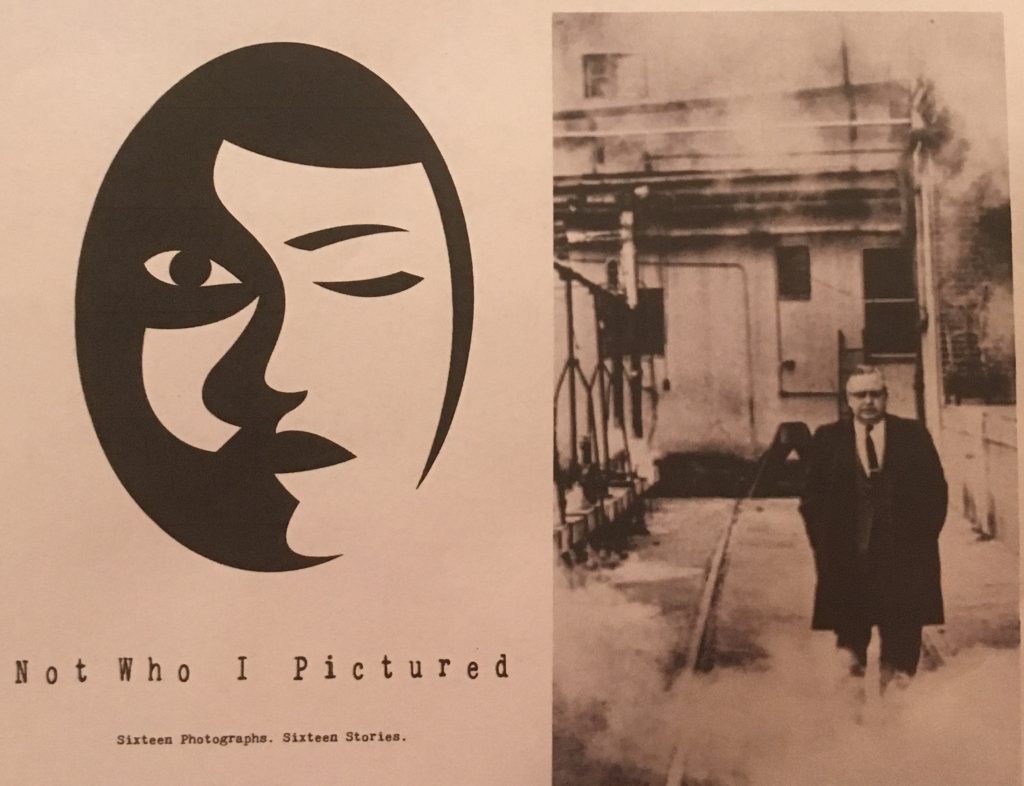
When Tino DeAngelis died, my grandmother called my mother and mentioned his death, and that there wasn’t a funeral or a wake for him. My grandmother was always private about her relationship with Tino. But my mother went to her house anyway after the phone call, without telling her she was coming. When my mother arrived, my grandmother cried, saying,
“You came.”
Tino was seventy one when he met my grandmother. He was renting her sister’s house. My grandfather died a few weeks after he moved in. Tino sent an extravagant bouquet of flowers to my grandfather’s wake. Then he began taking my grandmother out to dinner.
Tino and my grandmother kept seeing each other. She retired after working for forty years at a mental hospital. Tino liked to drive and took my grandmother on many trips. They took me on a trip to Canada when I was two years old. Tino must have been a wonderful person to spend time with for my grandmother who was, after all, a widow living in the town of Ovid, in upstate New York, where there was not a lot of adventure. Tino was full of adventure. He took my grandmother to Rome, Paris, Colorado, and bought her jewelry. They read books and planted flowers together.
My family doesn’t know the details of how their relationship began. But when my parents met Tino for the first time, he pulled them aside and said, “There are some things you should know about me…about my past.”
My earliest memories of Tino are seeing him with my grandmother on Christmas Eve, when my family would always go to my grandmother’s house. He was a short, stocky man with bulging eyes and a wide smile who was always shuffling around the kitchen. He would cook steak sandwiches, make my uncle champagne cocktails, shake my hand with a vice-like grip, and tell stories. He would call me a champion. He bought me my first racing bike with my named engraved on it, played handball with me when I was eight, and wrote me twenty five letters.
In one he wrote,
Dear Pal Jack,
God Bless You, young man. I hope this note finds you doing well in every way possible. Grandpa thinks of you every day and I just want you to know that I cannot wait until the day you reach the age where you have a driver’s license; I am going to get you a new Honda.
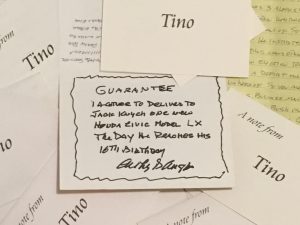
Despite writing in an informal contract: “Guarantee: I agree to deliver to Jack Knych one new Honda Civic model LX the day he reaches his 16thbirthday,” I never saw the car. But I loved Tino nonetheless, and I didn’t mind when he called himself Grandpa Tino. My family loved Tino as well.
But my grandmother’s relationship with Tino would be tested in 1992, when the F.B.I. invaded her home to arrest Tino for using $660,000 of forged letters from the Savings Bank of the Finger Lakes to purchase more than $1 million of pork from a Canadian firm. He would be convicted and sent to prison for the third time.
*
In 2010, a year after Tino’s death, I was in college pulling an all-nighter for my Financial Economics class. I was reading a book on the history of the stock market, when I came across a chapter on Tino. I almost fell out of my chair. I learned that he had almost caused the stock market to crash in 1963 by committing the most notorious white-collar crime in American history at the time, and that he had been a millionaire in the 1950s and 1960s. I remember thinking, “Was this really the same man who had been in love with my grandmother? Was this the same man who I had a picture of on my dorm room wall, posing ridiculously on an old-fashioned bicycle? And if so, who was he?”
The next day I called my father and had the truth of Tino’s crimes confirmed. When my father met Tino in 1985, he had been uncertain whether Tino was telling the truth concerning his criminal past, so my father went to the Bird Library at Syracuse University to check the newspaper archives to verify Tino’s story. Sure enough, Tino had been on the front of page of The New York Times for what called the “Salad Oil Swindle.” He had served seven years in federal prison for defrauding his clients for over $150 million (equivalent to $1.2 billion in 2018). For the next eight years I would intermittently research Tino’s life, to try and learn more about the man who tried to marry my grandmother.
*
Anthony “Tino” DeAngelis was born in 1915 in the Bronx, the oldest son of Italian immigrants. “Tino” translates to “endearing little fellow of the angels.” He grew up in poverty in a cold-water flat with four younger siblings. When interviewed by journalists later in life, Tino would reflect upon his childhood and say, ‘I wanted to do one thing in life – make a success. Even as a little kid, I partook very little of the gay life.”
Tino quit school at sixteen. Soon after, he borrowed $500 from his father, which he invested in a candy store. The candy store failed.
After the candy store went under, Tino would begin working as a helper at a meat market. One of the stories he would tell my family on Christmas Eve was about when he first saw a bicycle in a store. He told his mother,
“Let’s buy it,” and convinced the man behind the counter to give him the bike. “My father has a dependable job on the railroad,” he told the man. “We’ll pay through installments.” When Tino left the store with his mother and the bike, his mother said,
“Jesus Christ, Tino, your father is gonna kill me.” But Tino paid off the bike.
Within three years of working at the meat market, Tino had risen from helper to manager. By the age of twenty, he was managing two hundred employees.
When asked about being a manager at the age of twenty, Tino would reply, “There were always jealousies and stubbornness. But nothing deterred me. I’ve always had a brilliant and productive mind.”
*
Pragya Krishna wrote about her parents’ arranged marriage. Here’s an excerpt:
She [Pragya’s mother] had three older sisters, who’d all been married off, but she hadn’t really thought about the possibility that she was next.
When her brother’s wife saw she’d come home, she said, “Pinky,” (my mom’s nickname), “Take an hour to rest and then get dressed-up. There’s a boy coming to see you.”
“And I was so angry,” my mother recalls. “I said I don’t want to meet anyone. I had no decent clothes, I’d put on weight because I’d been binge-eating parathas because of the stress from studying. I was like, my hair’s like this, I don’t want to meet anyone.” But after her outburst, she calmed down as she always does, and obeyed, because that was what she did, especially if her parents had told her to do something. And these were her parents’ directions by proxy. “I said fine, and we started looking through my wardrobe. I found an old dhoti-type suit and I said, I’ll wear this.”
The boy arrived soon after and sat down in the living room. He had come with a friend. “I didn’t even know which one of them was the boy in question,” my mother says. She went into autopilot. Guests are supposed to be treated with courtesy, so she acted accordingly.
“Someone’s come to the house, I’m supposed to be an attentive hostess and be nice. ‘Please, have these rasgullas. I insist.’
“The young man in question, she says, had thought he didn’t want to marry a doctor. His friend, who is known to be tactless, said to her, “What if you were asked to forget you’re a doctor after marriage?”
She bristled.
The young man, however, intervened and said to his friend, “What kind of question is that? How would you feel if you were asked to forget you’re a scientist?”
“So then I thought, alright,” she says. “The guy has good sense.”
The rest of the conversation was just small talk, and when it was done my mom went back to her room and forgot about the whole thing. The young man came back later and picked up some pictures of her — a common practice during the arranged marriage process. “I didn’t know about it at the time,” my mother told me. “I was back to studying again. I paid no attention.”
But then, she says, “Exams were done, and my brother was like, okay, now you’re getting married.”
*
Chloe Picchio wrote about her grandfather, who grew up in a Pennsylvania mining town, became a soldier in hopes of experiencing adventure, then had his life shattered by the horrors of WWII:
Scranton, the county seat, soon became a symbol of the early 20th century’s hunger for wealth, like a character from the Great Gatsby who couldn’t spend their riches quickly enough. It was known as the “Electric City,” earning its nickname through the first-ever electric streetcars rolling down the avenues leading to an exotic menagerie of elephants and tigers at the local zoo. Five miles away, in Olyphant, those luxuries seemed like distant fantasies. Mining, even a generation removed from the underage breaker boys crushed to death under their coal carts, was dangerous and deadly. Anthracite mining required more blasting and deeper tunnels than those for bituminous coal, creating fragile coal seams where any small mistake became amplified with grave consequences. Explosions happened regularly, ignited by the little spark from a miner’s lamp or pipe. Hundreds of men died the year of my grandfather’s birth, their deaths by suffocation and gas explosion distilled into insurance company columns focusing on issues of liability and fault. This was all for $7.53 a day. The miners existed precariously at the bottom rung of the middle class, one workplace injury away from financial ruin. Still, it was enough to feed a family in the midst of the Depression, and the abundance of the coal fields was an exception in a country filled with homelessness and dust storms. Everyone in town worked in the mines whether they liked it or not. The earth underneath Olyphant’s main streets would occasionally buckle, the reverberations of a mining accident bubbling towards the surface, engulfing a home, a car, or a dream. My grandfather refused to be pulled underground with them. He wanted more…
…I always felt like my grandfather’s military service was an enigma. Throughout my childhood, it came in flashes, a brief viewing of his Purple Heart on Veteran’s Day or in the expensive patriotic floral arrangements my grandmother ordered without fail for his shelf in the mausoleum each Memorial Day. No one ever talked about what he actually saw because he rarely spoke about anything. Information dripped out like a leaky faucet, the discoveries infrequent but telling. Homemade jug wine prompted my great uncles to divulge that my grandfather had been in D-Day, painting a dramatic picture of how he stormed the beaches of Normandy, rivaling the opening sequence of Saving Private Ryan. That glory was tainted with awkwardness as they chuckled about how my grandfather had lied about his age, was caught, sent back to finish high school, and promptly returned to the army. Yet no one questioned his choice. Anyone who witnessed my grandfather’s decision is now either dead or ill. But in the end, it really doesn’t matter. What matters is what he saw and could never unsee….
*
To buy the book on Amazon, click here
More excerpts on the Medium Page
Listen to the Podcast
Subscribe below:
According to Mary Meeker’s annual Internet Trends report, in 2014 people uploaded an average of 1.8 billion digital images every single day. To put this in perspective, every two minutes humans took more photos than existed in total 150 years prior. GOD DAMN. No doubt this number has increased substantially in 2018…as more people have phones with cameras and meals that must be posted on Instagram. With such quantity, such instantaneous feedback, and such convenience, has the quality of photographs improved or suffered? What are the ingredients of a quality photograph? Perhaps the clarity and shock-value of particular photographs have improved, but has something subtle been lost when you don’t have to stay up all night developing a photograph in a dark room, but instead can press a few buttons and upload the image on to social media? Does the search for meaningful subjects become compromised when you can instantaneously capture and develop/add a filter to an image? How much can someone’s character be judged by the photographs they choose to take? I don’t know. But by looking at the past work of Margaret Bourke-White, a photojournalist between 1925-1960, answers to these questions may be reached. Because Bourke-White was, interestingly, both a first and a last artist, meaning one of the first photojournalists to make a career out of taking photos, but also one of the last journalists who had risen to success through the old fashioned way of photography. Whether she created timeless art is for you to judge. But her art aside, she was also a powerful woman who lived on the edge…here is her life:
Margaret Bourke-White was born on June 14th, 1904. As a child she showed a sense of adventure and a curiosity for life, as one summer she raised two hundred caterpillars under rows of upside-down glasses on a dining room windowsill.
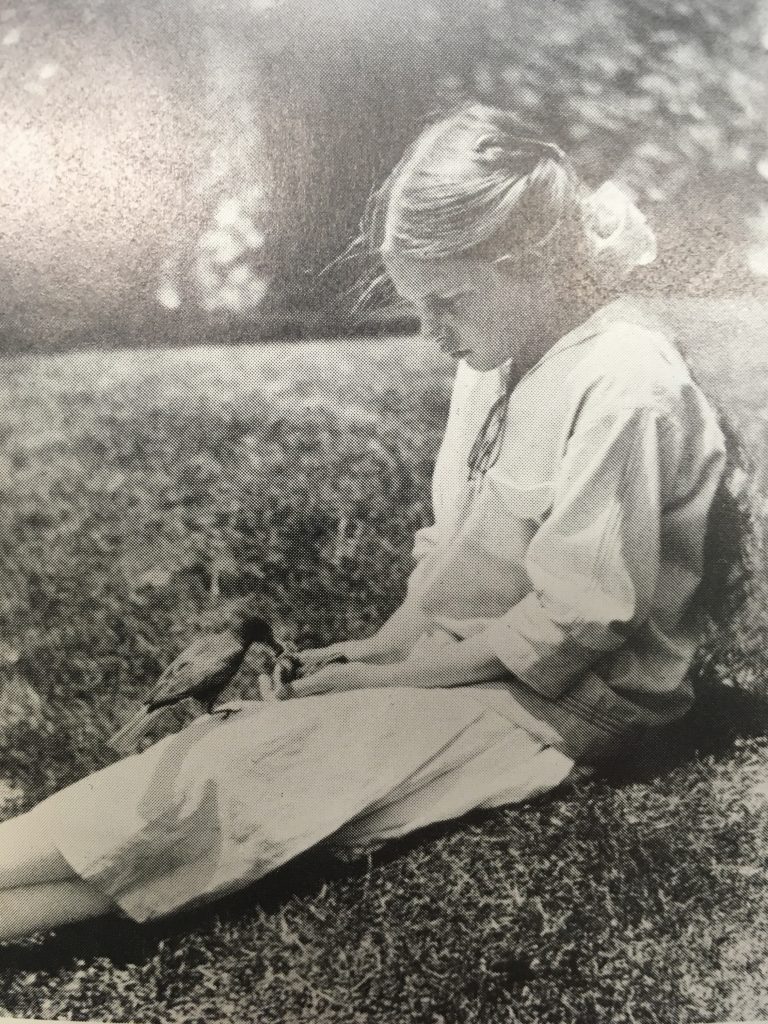
She was very close with her father, Joseph White. He’d take her on walks outdoors, teaching her how to decipher between harmless and dangerous snakes, and how to pick them up without fear. With her father’s introduction to the world of snakes, Margaret decided to become a herpetologist. Her motivation to study snakes was fueled by a desire to travel and a desire to do “things that women never do,” (MBW, 14). Her father encouraged her herpetology by constructing wire cages to house her growing collection of snakes and turtles. Margaret would major in herpetology when she enrolled at Columbia University at the age of seventeen.
Joseph White was an amateur, though passionate, photographer. He was a stern, silent man who was not to be disturbed in the house while he was “thinking.” Joseph was an inventor who worked with printing presses, earning numerous patents such as the first printing press for Braille. During his life he would dedicate his “heart and mind to a tangled love affair with the rotary press,” but due to failed investments would never become wealthy (G, 101). He was, “Always tinkering with lenses and working on devices to make exposure settings simpler for the amateur [photographer]…” (MBW, 20). He would take Margaret on trips to factories where he was supervising the setting up of presses. On one of these trips, Margaret witnessed the flowing of metal and flying sparks in a foundry, and would write about the experience later in life: “To me at that age, a foundry represented the beginning and end of all beauty.”
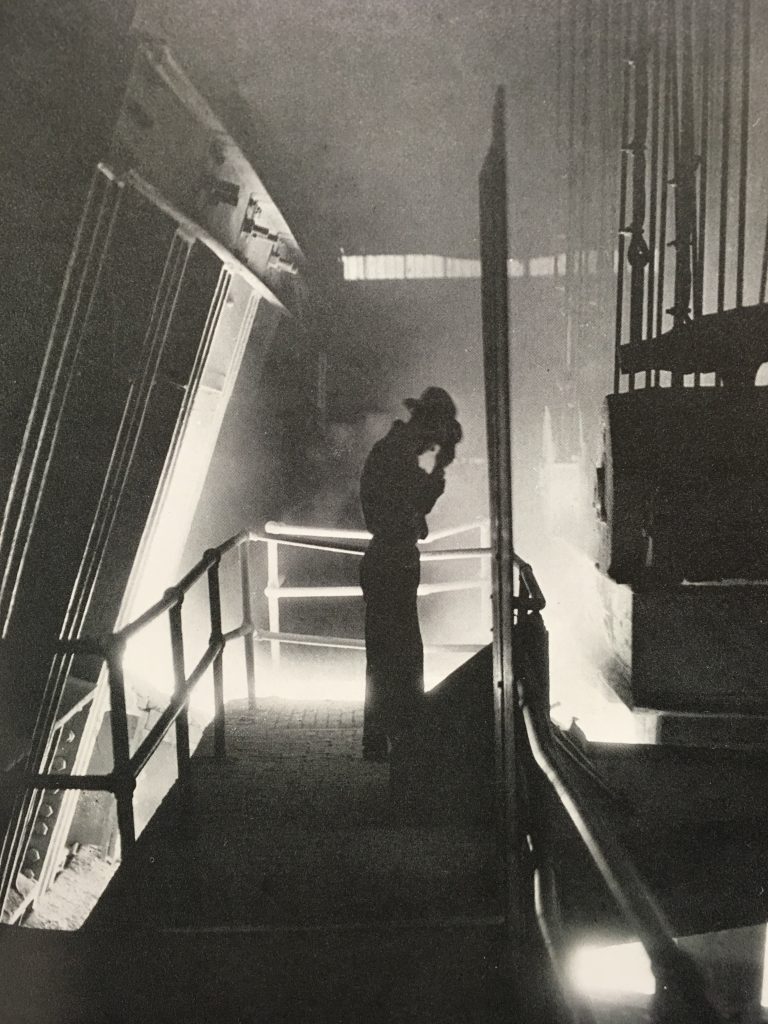
Her father instilled in her a love for industry and work. On industry, Margaret would write:
“Ore boats, bridges, cranes, engines – all are giant creatures with steel hearts. They all have an unconscious beauty that is dynamic, because they are designed for a purpose. There is nothing wasted, nothing superficial. The realization of this idea will grow. It reflects the modern spirit of the world,” (G, 112).
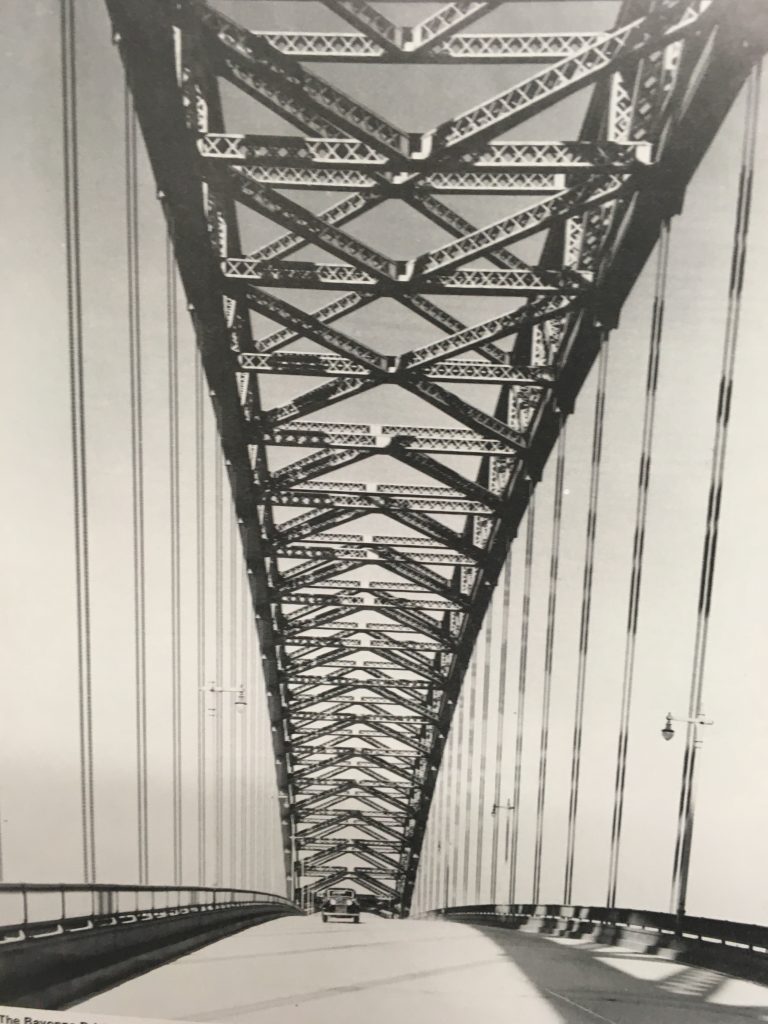
And on her father instilling a work ethic, Margaret would write:
“His [Joseph White] positive contribution was to build in me the deepest respect for work. Work is a religion to me, the only religion I have. Work is something you can count on, a trusted, life-long friend who never deserts you.”
While a freshman at Columbia University in 1921, Margaret’s mother bought her a camera, a 3¼ x 4¼ Ica Reflex. It cost $20 and had a crack in the lens. At Columbia, even though she majored in herpetology, Margaret would also study art. She’d hear a lecture by the artist Arthur Wesley Dow, who was teaching at Columbia University Teachers College, and would later use his Orientalizing design principles in her photographs of gardens and estates in Cleveland (G, 68). In addition, the teachings of Arthur Wesley Dow grounded her thoroughly in the potential of abstraction from realistic observation (G, 111).
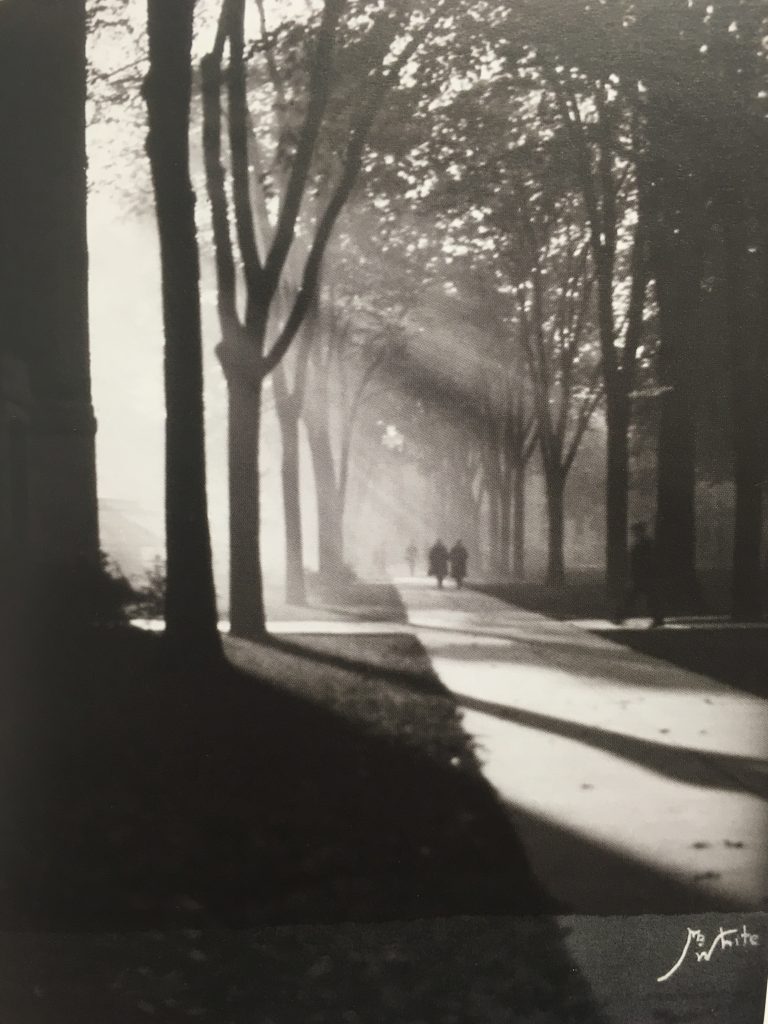
Then, by lucky chance (according to Margaret) she took a two-hours-a-week course in photography under the late Clarence H. White, “…not because I wanted to take photographs but because the course dealt with design and composition as applied to photography.” But in her notes later in life she also reflected, “I think my great love for my father and the fact that he was so much interested in photography was a strong added incentive when I began work at the Clarence H. White School,” (G, 24).
Margaret wrote in her autobiography that, “…Clarence H. White was a great teacher and the [photography] seed was planted.” One of her classmates, Ralph Steiner, would become a colleague for life, giving her technical advice on photography over the years. In their first class together, Ralph said Margaret had, “Terrible, intense, staring eyes that didn’t blink,” like the cold-bloodied animals she studied. When Margaret would study at Cornell, she would describe Steiner as a “superbly sharp honest craftsman,” who “caustically talked me into a fierce reversal of the viewpoint that a photograph should imitate a painting,” (MBW, 30). He would take photos of Margaret later in life:

After a disastrous marriage and attending numerous universities after Columbia University, Margaret would move to Cleveland into a tiny apartment by herself. She’d develop films in her kitchen sink, rinsing them in the bathtub. The first photograph she would sell commercially would be a picture of preacher and pigeons, which she sold to the magazine of the Cleveland Chamber of Commerce for ten dollars:
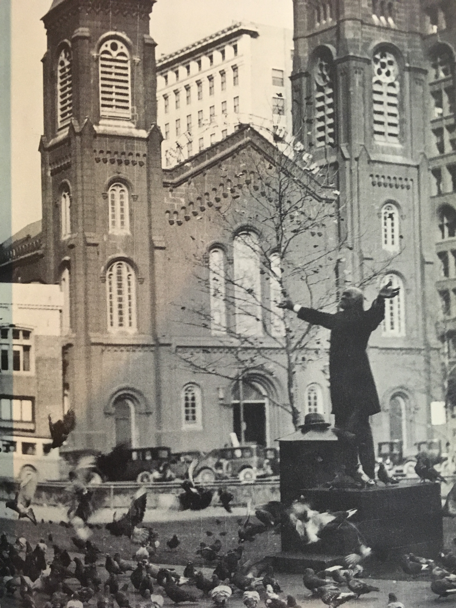
In 1927, Margaret was constantly visiting industrial sites, saying, “I can’t describe the feeling of rapture and real ecstasy that I had when I got to all that industrial activity,” (G, 74). The majority of her photographs around this time concentrated on dynamism, movement, construction, process, teeming steel, the pouring of metal, and coke being quenched. She began to realize the democratic power of photographs, as, “Even in its most complex combinations, anyone can understand most photographs.”
The same year a friend of Margaret’s suggested that she bring her industrial pictures to the Union Trust Company. The Union Trust Company was desperate for covers for their monthly magazine called Trade Winds. After they saw Margaret’s portfolio, they agreed to give her $50 for its cover, a picture of the High Level Bridge. They would continue with this monthly payment contract for the next five years. As Margaret began to receive more money for her work, her certainty in her path grew:
“…I didn’t know exactly what direction I was headed except that it was upward. I didn’t know exactly what my goal was. I didn’t see a fixed goal but I knew that I was progressing and that I would succeed,” (G, 78).

In 1927 American industry was reaching a peak of profits and productivity. The respect for business was reaching a kind of national reverence. The time was ripe for someone like Margaret to inform the capitalist that in the means of production lay the sparks of high art. Between 1921-1929, industrial production in the United States nearly doubled. President Calvin Coolidge would say, “The man who builds a factory builds a temple, the man who works there worships there.” And Henry Ford believed that “machinery is the new Messiah.” Margaret’s timing was perfect, and her pictures of dynamo in the Niagara Falls Power Plan in 1928, taken for the state set of Eugen O’Neill’s Dynamo, earned Margaret the reputation of “The girl who discovered the dynamo,” (G, 81).
But her breakthrough would come when she went to the Otis Steel plant to take photographs. When she arrived, the pouring of the metal gave off more heat than light, and Margaret would end up improvising with flares to achieve better lighting. In addition, a few days after she started work, a corporate publicist named John Hill wrote, “I had a call from the night superintendent of the mill. He demanded that I keep ‘that girl out of the plant,’ he said. ‘She’s crawling all over the place, and the men are stumbling around gawking at her. Someone is going to get hurt, and besides, they’re not getting any work done.’” Margaret replied, “I’ll wear blue jeans,” and returned to the mill. This would be one of many examples of Margaret experiencing backlash in a male dominated industry. The picture of the mill’s two hundred-ton ladle would win her the first prize at the Cleveland Museum of Art show in May of 1928. She would later write, “I feel that my experimental work at Otis Steel was more important to me than any other single thing in my photographic development.”
Work was becoming the main focus of her life. She would write Nikolai Sokoloff, one of her many lovers:
“You have never seen me at work. You cannot know how my work has been all of me, and how unwilling I have been to let anything outside of my work seem important to me – Everyone here knows how independent I am and how unapproachable I am. I made up my mind that I would not allow myself to get fond of anyone until I am over thirty. I shall abide by that, because nothing is so important to me just now as to do something in pictures in black and white with the romance and beauty of industry that has never been done before…I have made up mind quite definitely that I cannot fall in love with anyone until I am thirty…” (G, 90).
Even though Margaret was not the first woman to take industrial photographs, she was the first woman who was commercially successful in the field. She was a pioneer for bringing the image of industry to the attention of the American public and giving it a glamour and power it had not had before (G, 90).
In early 1929, Henry Luce saw her Otis Steel pictures in the rotogravure section of a mid-western newspaper. He sent a cable to Margaret which read:
“HAROLD WENGLER HAS SHOWN ME YOUR PHOTOGRAPHS STOP WOULD LIKE TO SEE YOU STOP COULD YOU COME TO NEW YORK WITHIN A WEEK AT OUR EXPENSE PLEASE TELEGRAPH WHEN – HENRY R LUCE PUBLISHER TIME THE WEEKLY NEWS MAGAZINE.” Margaret raced to New York to meet him.
Henry Luce told her that he wanted her to be the first photographer for Fortune (which had initially been planned to be called Power), his new magazine. In the magazine “pictures and words should be conscious partners,” and “the camera would act as interpreter.” He wanted the magazine to have “the most dramatic photographs of industry that had ever ben taken.”
Luce knew that his magazine Fortune and eventually his other magazine, Life, were new means of communication and would change the very nature of reporting. In the past, a magazine would write a story, then a staff would look through an index of important images. Now, the magazine often had the story written, not before, but after the photographs came in (G, 109).
Fortune’s popular appeal was its illustrations, and Bourke-White was the force behind this appeal. She would make industry a theatre (G, 110). In addition, Fortune would feature pictures of politicians caught in mid-gesture, or of statesmen seen through half-opened doors, and these un-posed photographs were revolutionary. The public had never seen this new form before and it was a breakthrough for the press (G, 110).
Throughout this revolution, Margaret was on the center stage. And being a woman enhanced the spotlight. Margaret didn’t play the game the way that women were expected to, with a “sweet and retiring demeanor,” (G, 150). Her famous, often repeated line was, “Nothing attracts me like a closed door. I cannot let my camera rest until I have pried it open, and I wanted to be first,” (G, 125). When asked why she was often single, Margaret would reply, “I don’t need someone else to cling to and I don’t have the need of security that a lot of women do. First of all, not financial security, but even more important, emotional security,” (G, 321). A man told her once she had a lens for a heart. She took it as a compliment and happily repeated it (G, 273).
In 1936 Henry Luce received a telegram from Archibald MacLeish:
“The great revolutions of journalism are not revolutions in public opinion, but revolutions in the way in which public opinion is formed. The greatest of these, a revolution greater even than the revolution of the printing press…is the revolution of the camera…The camera shall take its place as the greatest and by all measurements the most convincing reporter of contemporary life,” (G, 172).
Today, as photographs are so integrated into our daily lives and culture, it’s difficult to comprehend the revolution of photographs becoming a part of the news.
In 1936, Luce decided the world needed a picture magazine, and came up with the idea for Life magazine. He wrote in the first draft of the prospectus: “We have got to educate people to take pictures seriously, and to respect pictures as they do not now do…While people love pictures, they do not respect them,” (G, 174). He hired Margaret two months before publication. Margaret was the only woman and the only big-camera photographer for Life. Her first assignment was the chain of dams that the Public Works Administration was constructing in the Columbia River Basin to control flooding, which would go on the cover of the first issue.
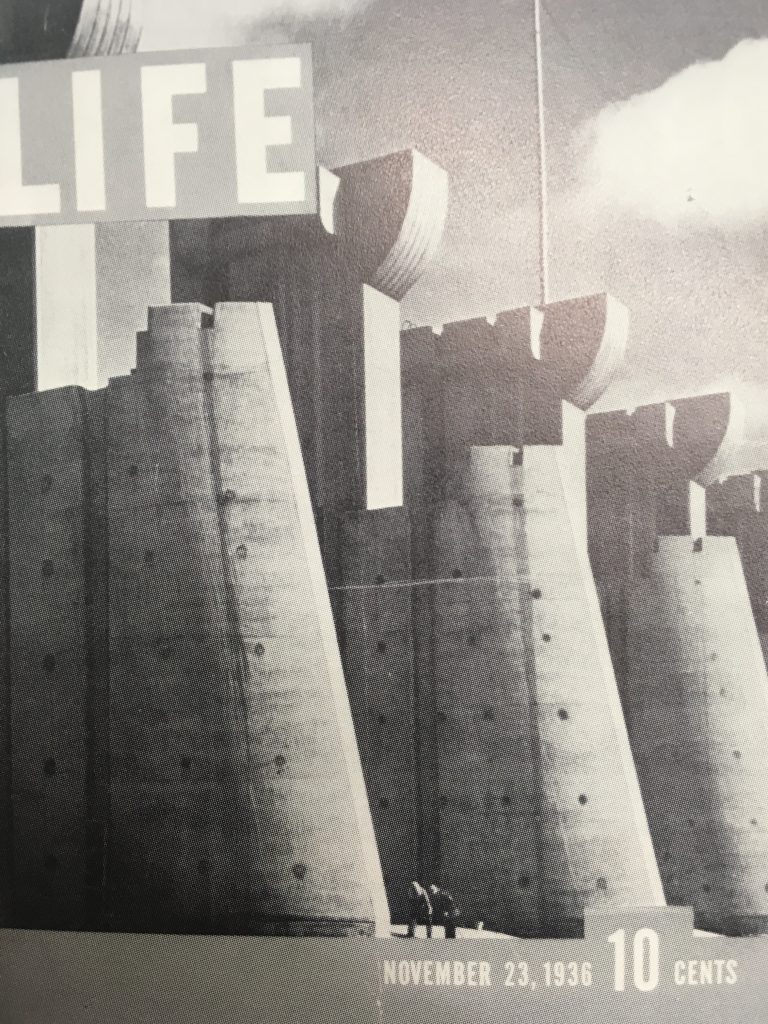
Before Life, no other illustrated periodicals in the world gave the news (or any other kind of story) principally and coherently in photographs. In Life Margaret would pioneer the picture essay, as in the first issue the lead story was about what normal, useful, pleasant behavior was like out West, which was the first true photographic essay in America, (G, 181). Margaret would say, “One of the things I really care about is being given credit for having this essay style,” (G, 180).
In comparing Life to new forms of media and news today, it’s interesting to note that Life didn’t turn a profit until 1939, three years after the first issue. And, the editor at Life had to teach his staff to read pictures, with captions at first being written to help teach the public how to read evidence. People were concerned that the picture magazine would kill off reading.
But reading was not killed off, and photos in Life were seen as the great equalizer, as an ad in Life in December of 1936 wrote:
“The appeal of pictures is universal…the cook and taxi-driver, then may find something in LIFE as interesting as you do,” (G, 183).
Henry Luce saw photography as a kind of remedy for the disheartening effects of the news. In 1952, Life reminded its readers that, “Back in 1937…Henry R. Luce…predicted that photography could be useful in correcting that really inherent evil of journalism which is its imbalance between the good news and bad,” (G, 187).
While working for Life, Margaret would engage in other projects, such as the collaborative book, You Have Seen Their Faces, with her famous novelist husband: Erskine Caldwell. The book, a 1937 report on sharecropping and an indictment of the practice, would influence the country’s legislation and establish a new genre: a book in which photographs and text have equal weight. A New York Times reviewer of the book wrote, “The pictures produce such as an effect, indeed, that it is no exaggeration to say that the text serves principally to illustrate them,” (G, 194).
*
Margaret Bourke-White’s life, as she rode on top of the wave of photojournalism and the first successful photographic magazines in the United States, would be full of adventure. She captured the Dust Bowl, the Soviet Union’s five year plan, she was the only photographer who captured Stalin smiling, she was in a submarine in the Mediterranean that was torpedoed and had to abandon ship, she went on a bombing mission attack on Tunis as the first woman to accompany a U.S. Air Force on a combat mission, she would be in Moscow during the bombing in July of 1942…
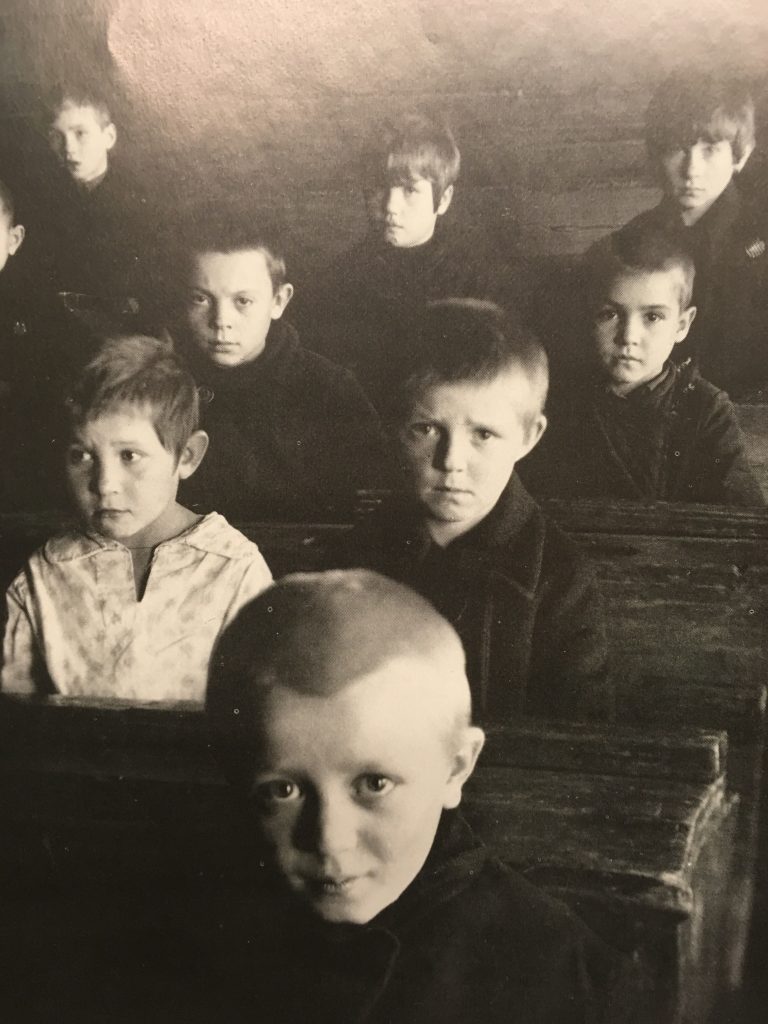
…she flew with Hamp Atkinson and Paul Tibbetts (Tibbets would, two years later, drop the first atomic bomb on Hiroshima), she liberated Buchenwald concentration camp…
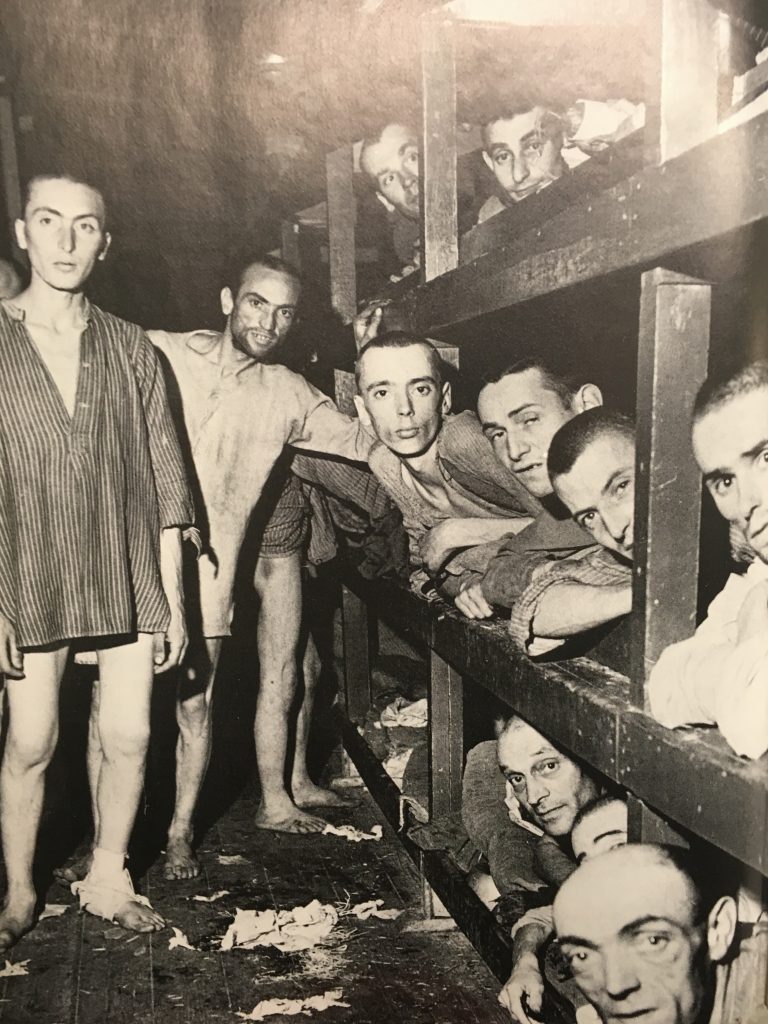
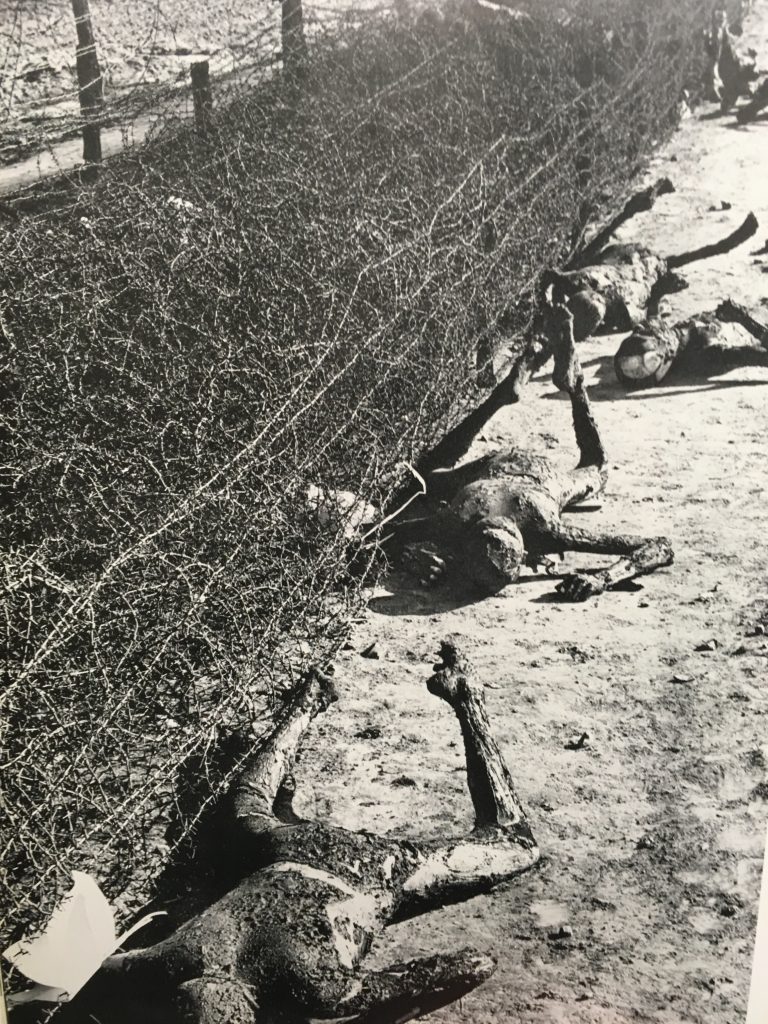
…she photographed the iconic image of Mahatma Gandhi sitting behind his spinning wheel…
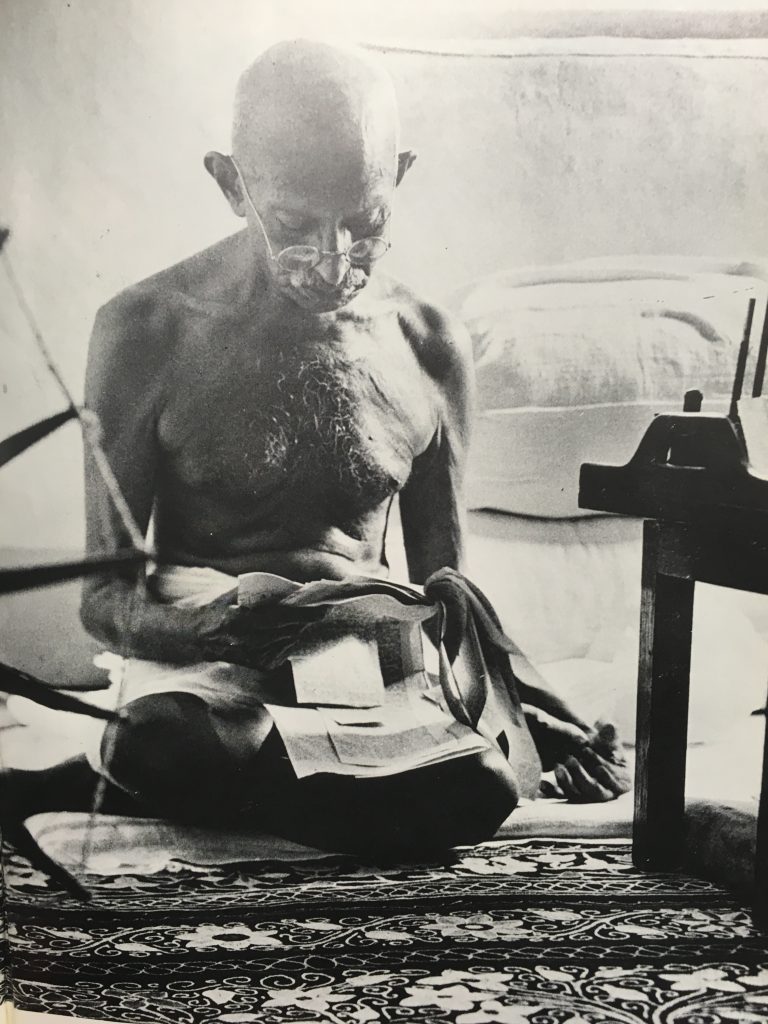
…then interviewed him the day he was assassinated, and she covered the Korean War.
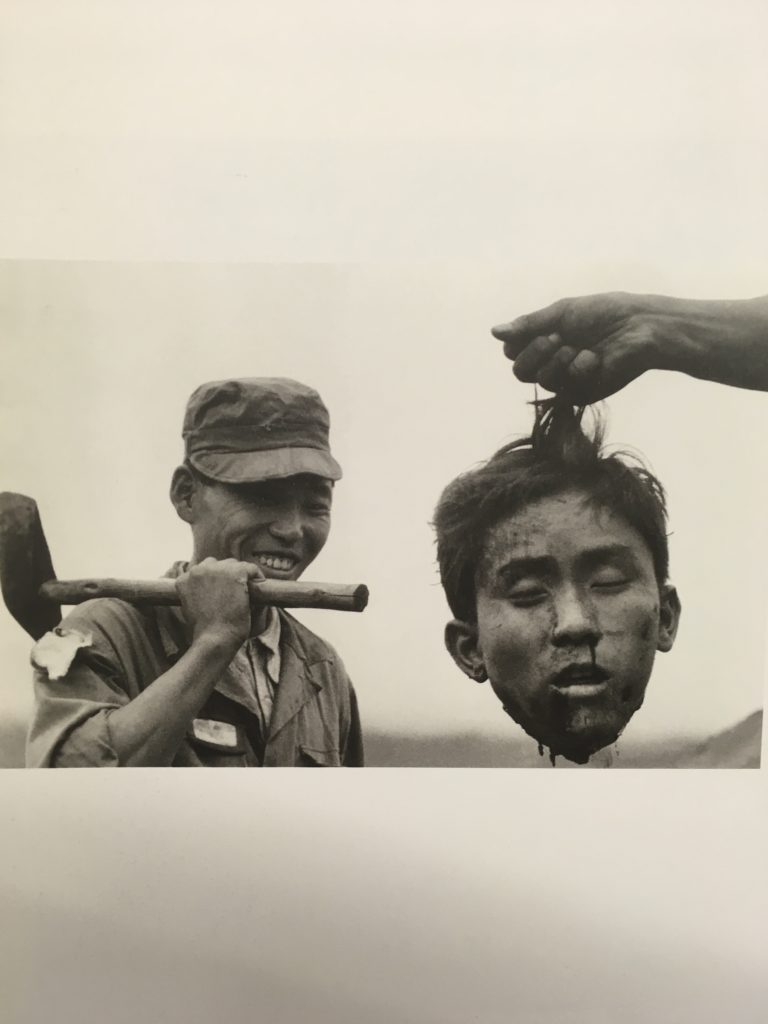
So it seems a cruel twist of fate that a life of such action would be crippled by Parkinson’s Disease in the last eighteen years of her life. As Margaret developed Parkinson’s (she wouldn’t tell friends or co-workers for years after showing symptoms), she would say to a friend, “I feel like a prison in my own self,” (G, 343). She would write, “Parkinsonism is a strange malady…it works into all paths of life, into all that is graceful and human and outgiving in our lives, and poisons it all.” But despite the inner torment, Margaret never claimed that life had treated her unfairly, as her friend Jack Hofkosh noted, “She never asked the one question everyone asks without fail: “Why me?’ The question forced itself on her mind, but she adamantly refused to give it space,” (G, 351).
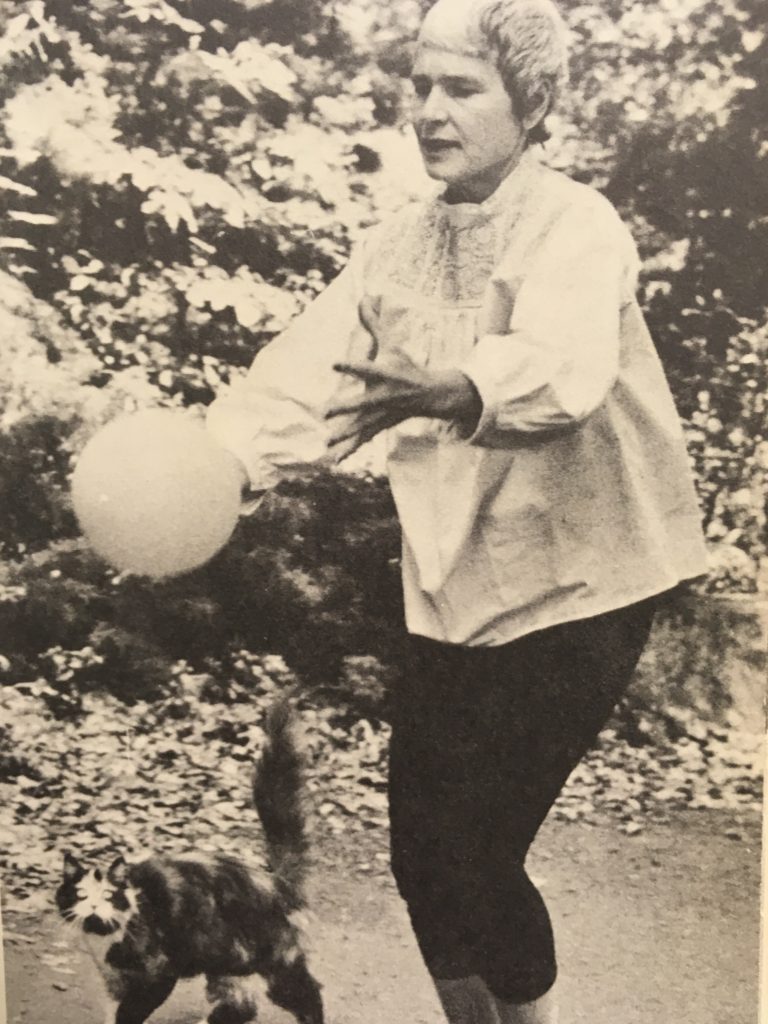
In fact, in 1955, two years after experiencing Parkinson symptoms, Margaret asked Henry Luce to promise her the assignment for the first trip to the moon. Luce gave her his blessing (G, 347). To the end, Margaret loved life and adventure, overcoming obstacles in stride, even when they seemed unexplainable, as she would write near the end of the life:
“…from whence come the trials by fire. Seems so purposeless, so underserved. Undeserved is something we cannot judge and the very word had to be exiled outside of our consciousness or we could waste what little life we have ahead by complaining that we don’t deserve such fate.” (G, 351).
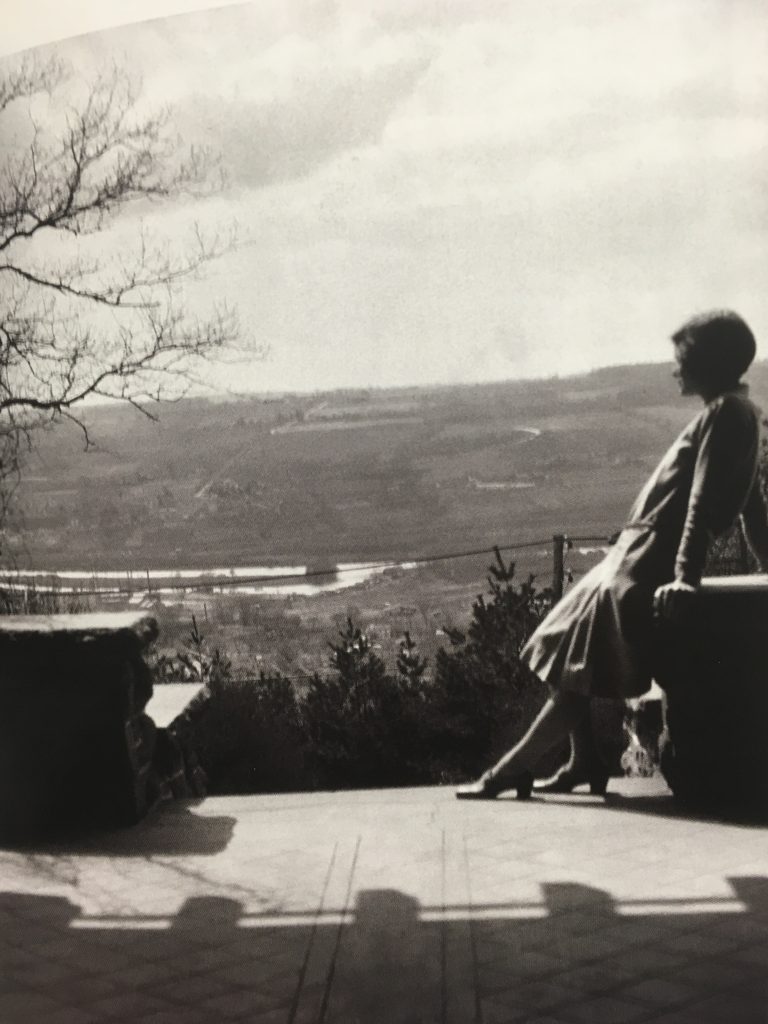
Subscribe below:
Project for my Video 1 Class. I have a long way to go:
“The Importance of Failure”
Co-authored piece published in The Freeman Magazine then re-published in FEE (Foundation for Economic Freedom) October 26th, 2011. Presented at APEE (Association of Private Enterprise Education) in spring of 2012 at “Best of the Freeman” panel.
4 minute read
[button color=”blue” size=”” type=”square” target=”” link=”https://fee.org/articles/the-importance-of-failure/”]Read Now[/button]
Subscribe below:
“Bed-Stuy provides fertile ground for eviction company Quick Evic”
1.5 minute read
Published in amNewYork on November 27, 2017
Subscribe below: